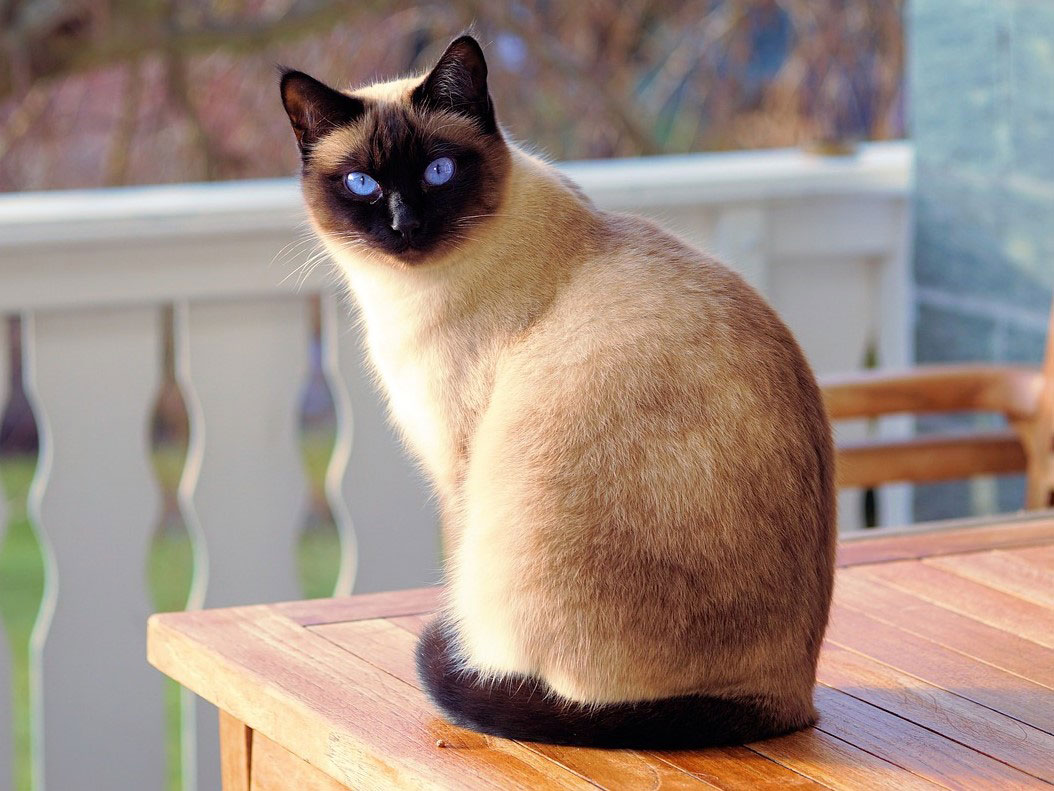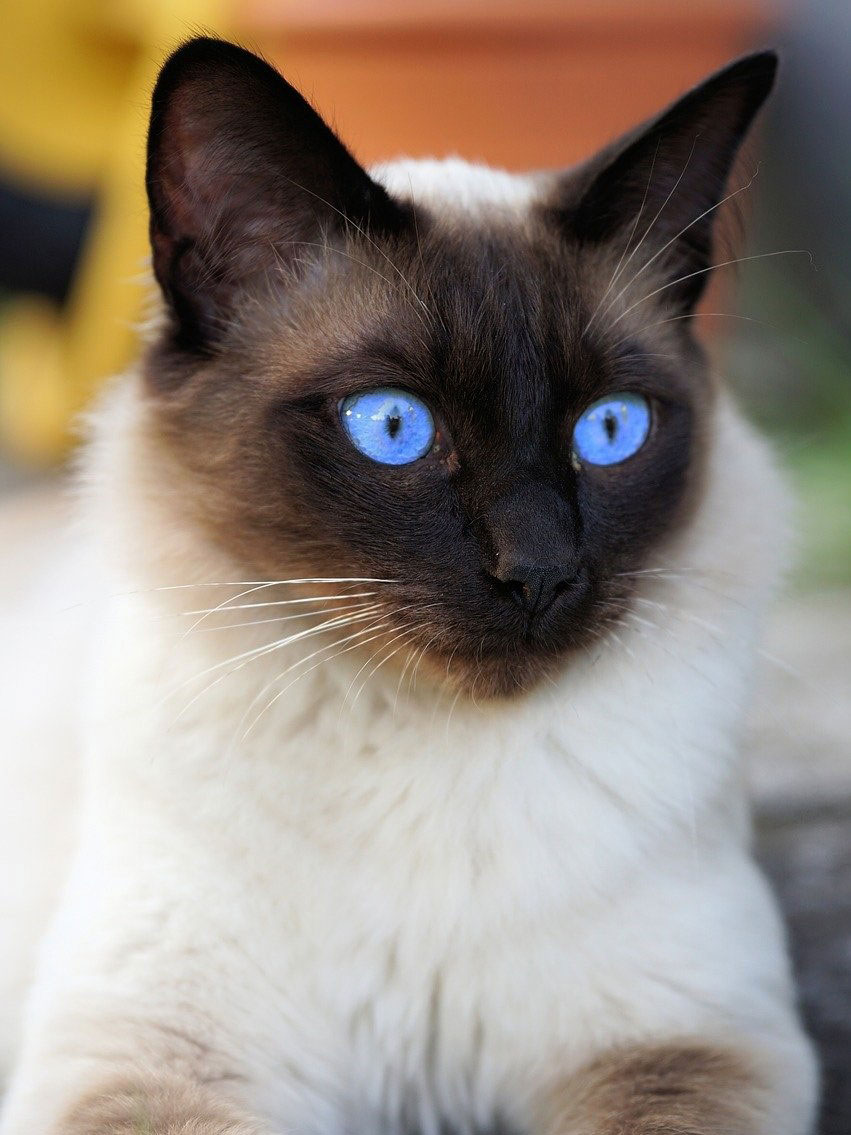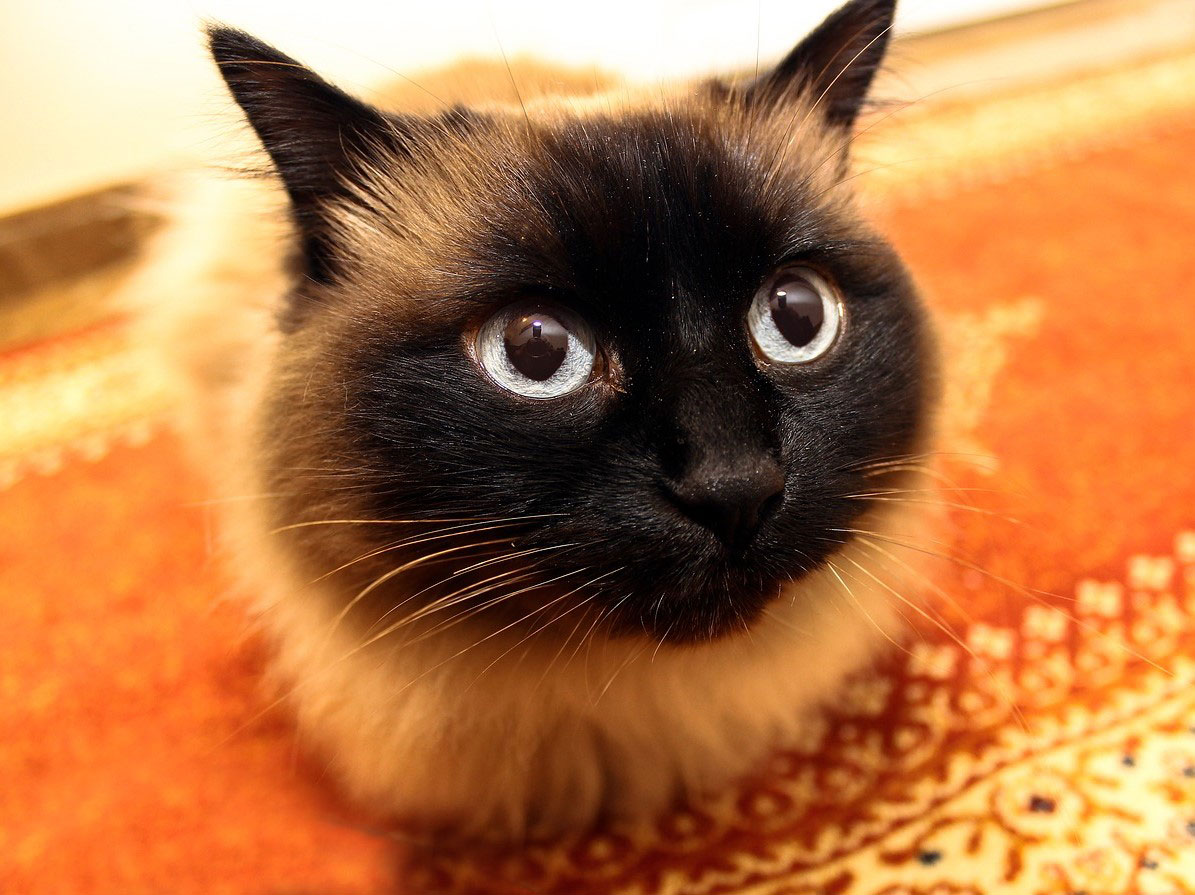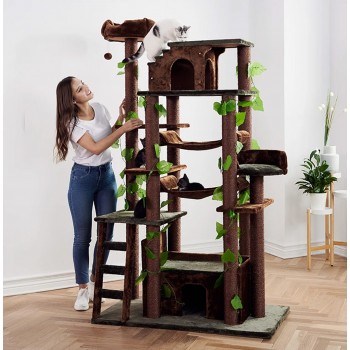
 The Siamese is not only one of the most ancient breeds but also unique because its dark coat markings change based on its temperature. This results from a temperature-sensitive enzyme that paints the cooler parts of the cat’s body dark – a real masterpiece of Mother Nature!
The Siamese is not only one of the most ancient breeds but also unique because its dark coat markings change based on its temperature. This results from a temperature-sensitive enzyme that paints the cooler parts of the cat’s body dark – a real masterpiece of Mother Nature!
Famous for its piercing eyes and striking color points, this breed is also incredibly social and intelligent. Now, let’s learn more about these unique felines.
History of Siamese Cats
It’s believed that Siamese cats first appeared in Siam's ancient Asian land (nowadays Thailand), and that’s how the breed got its name. According to The International Cat Association (TICA), manuscripts from Siam's ancient capital first mentioned the Siamese around 1350.
In Siam, the stunning cats were exclusive to the royal family and the higher class. It was a great honor to receive a Siamese kitty and the theft of one was punishable by death. It’s also said that the Siamese cats guarded the sacred Buddhist temples.
 The Siamese were noted for their crossed eyes and kinked tails at the time. The legend goes that this happened because the cats of Siam - pets of the king of Siam himself – had to guard the royal goblet. The felines stared at the goblet and wrapped tails around it with such intensity that their eyes crossed and their tails bent.
The Siamese were noted for their crossed eyes and kinked tails at the time. The legend goes that this happened because the cats of Siam - pets of the king of Siam himself – had to guard the royal goblet. The felines stared at the goblet and wrapped tails around it with such intensity that their eyes crossed and their tails bent.
These Siamese cat characteristics were selectively bred out over time, although some Siamese still have crossed eyes and kinked tails. Unfortunately, today cats with crossed eyes and visible tail faults are disqualified at TICA shows.
The beautiful felines lived in Siam for hundreds of years before being transported to Great Britain in the late 1800s. According to the New York Times, in 1871, Siam's King Chulalongkorn sent some Siamese breed cats to Europe as emissaries presenting his kingdom. Other sources say that one of the first to take Siamese to Europe was the British consul in Bangkok, Mr. Owen Gould, who brought a pair of cats for his sister – Mrs. Veley. She later co-founded the Siamese Cat Club.
It’s also known that in 1871, the Siamese cats made their European debut at the Crystal Palace Cat Show in London. In 1879, the first Siamese arrived in the United States as a gift from a US diplomat in Bangkok to the wife of President Rutherford Hayes. In the western hemisphere, the Siamese breed was known as “The royal cats of Siam” or the “Temple cats.”
Unique coat and colors of Siamese cats
 The Siamese coat is known as “pointed” because it has darker points on the ears, mask, legs and tail, in other words, on the extremities. These points may come in different colors, including seal, lilac, red, silver, chocolate and blue. Thus, chocolate-point cats are those with light brown markings on the extremities, and blue-point cats have blue-grey extremities.
The Siamese coat is known as “pointed” because it has darker points on the ears, mask, legs and tail, in other words, on the extremities. These points may come in different colors, including seal, lilac, red, silver, chocolate and blue. Thus, chocolate-point cats are those with light brown markings on the extremities, and blue-point cats have blue-grey extremities.
These unique coloration points are temperature-sensitive and result from the mutation of the enzyme tyrosinase. This enzyme is essential to producing melanin, responsible for hair and skin color.
In Siamese cats, the mutated enzyme tyrosinase is less active when the cat’s body temperature is higher – so in the warmer parts of the body, the fur color is lighter as melanin is not produced. On the opposite, in the cooler parts of the body – the extremities such as the ears, tail and paws – the enzyme is active and melanin is produced, so the coat is dark.
It’s interesting that Siamese kittens are cream or white at birth. They develop visible points in the colder parts of their bodies with time. Usually, when a kitten is four-weeks-old, the points are distinguishable, and a person can recognize the kitty’s color.
Physical characteristics of Siamese
 The most noted characteristics of Siamese cats are the expressive eyes (blue or emerald green) and the contrast between those eyes and the “pointed” coat.
The most noted characteristics of Siamese cats are the expressive eyes (blue or emerald green) and the contrast between those eyes and the “pointed” coat.
Today, however, two kinds of Siamese exist due to years of selective breeding. The first kind is the traditional (apple-headed) Siamese and the second – is the modern (wedge-headed) Siamese.
The first one has a round head and looks like the Siamese cat originally imported from Siam. This cat has a sturdier build and eyes shaped like almonds in the top half and rounded in the bottom half. There is a slight break in the nose, the ears are medium-sized and the muzzle is blunt but not short.
The wedge-headed Siamese kitty resulted from the breeders’ intent to encourage an elongated look, which emerged in the 1950s and 1960s. The modern Siamese has a triangular or wedge-shaped head, from which the breed gets one of its nicknames – Wedgies.
The modern Siamese cats have large, triangular ears set far apart and slightly slanted blue eyes. They have a long, slender, tubular body with long legs, a graceful neck and a long, whip-like tail.
Both of these types have striking eyes and a great personality.
The personality of a Siamese cat
 One of the Siamese cats' most praised characteristics is their personality—these cats are very intelligent and affectionate. They can also be described as outgoing, extroverted or energetic. They love interacting and playing with people or animals and are perfect for those who want a lively pet.
One of the Siamese cats' most praised characteristics is their personality—these cats are very intelligent and affectionate. They can also be described as outgoing, extroverted or energetic. They love interacting and playing with people or animals and are perfect for those who want a lively pet.
Be prepared, though—the Siamese are super smart and need to be kept amused. They will follow you around and demand to be part of your activities. They don’t like to be ignored, either, so offer lots of toys. Perches and scratching posts would be helpful, too, and the Siamese can be easily trained to use them.
This breed of cat can also learn to play fetch, walk on a leash, and do tricks. They are social and will do anything to spend time with you. They crave human companionship and can get depressed if left alone for too long.
We have to mention that Siamese are also known as demanding cats. They often voice their opinion loudly, using a wide range of meows and chirps. As the Cat Fanciers’ Association points out, The Siamese voice is legendary—this cat speaks both with voice and body.
Overall, these cats are very loving, talkative, amusing, and social and make great pets.
Siamese breed group
 The Siamese is the parent breed for the group that includes the Balinese (a long-haired Siamese), and the Oriental Shorthair and Longhair. The coats of the Siamese cat and the Oriental Shorthair are very short and fine-textured. Balinese and Oriental Longhair cats have semi-longhair coats with a slight undercoat and silky texture.
The Siamese is the parent breed for the group that includes the Balinese (a long-haired Siamese), and the Oriental Shorthair and Longhair. The coats of the Siamese cat and the Oriental Shorthair are very short and fine-textured. Balinese and Oriental Longhair cats have semi-longhair coats with a slight undercoat and silky texture.
The Cat Fanciers' Association refers to the red-, tortoiseshell- and lynx-point cats as Colorpoint Shorthaired, but in all other respects, these cats are the same as the traditional brown, chocolate or black cats.
The Siamese cat breed has also been used to develop other breeds such as Birman, Burmese, Havana Brown, Himalayan, Javanese, Snowshoe, Tonkinese and others.
How to take care of a Siamese kitty
 The Siamese cat craves company and affection, so a person interested in this breed only because of its beauty should think twice before getting a Siamese kitty. If you are the type of person who travels often and is away all day, you should at least get two cats. This way, these active creatures can entertain each other.
The Siamese cat craves company and affection, so a person interested in this breed only because of its beauty should think twice before getting a Siamese kitty. If you are the type of person who travels often and is away all day, you should at least get two cats. This way, these active creatures can entertain each other.
It’s important to note again that Siamese are high-energy cats that bond strongly. They enjoy the companionship of humans and other animals, and of course, each cat has its personality.
Overall, Siamese cat breed:
- Are good with kids and other animals.
- Have a low-maintenance coat.
- Need daily play sessions that stimulate their natural desire to bond and explore.
Shedding and Allergies
 Even though they don't shed excessively and do it only twice a year, the Siamese enjoy being combed or brushed. Grooming is easy due to the short coat, and brushing twice a week would be appreciated by these felines, who crave attention.
Even though they don't shed excessively and do it only twice a year, the Siamese enjoy being combed or brushed. Grooming is easy due to the short coat, and brushing twice a week would be appreciated by these felines, who crave attention.
The Siam cats are a good pick for someone usually allergic to cats. Although no cat is truly hypoallergenic, some cats shed less and produce less of the allergen that causes trouble. It's good to know that most people are allergic to a cat’s dander – a mixture of proteins found in the skin glands, saliva, and urine.
Also, Siamese toms secret more allergens than female cats, so if you are concerned about allergies, choose a female cat that is lightly colored, with lilac or blue points.
Food
The Siam cats are hardy with a good appetite. They like to stay active, so it's best to offer them high-quality food recommended by a vet or a breeder. This type of cat is opinionated and will soon tell you how much food it requires daily. As with all other cats, excessive weight could be a problem, and free feeding should be avoided.
Castration
 Most Siamese felines reach sexual maturity at an early age; therefore, it is recommended that they be spayed or neutered at 6 months. They are medium-sized cats, with the males a bit larger than the females. Males weigh 10 to 15 pounds, and females weigh between 8 and 12 pounds. The average litter size for Siamese is about six kittens, but larger litters are not uncommon.
Most Siamese felines reach sexual maturity at an early age; therefore, it is recommended that they be spayed or neutered at 6 months. They are medium-sized cats, with the males a bit larger than the females. Males weigh 10 to 15 pounds, and females weigh between 8 and 12 pounds. The average litter size for Siamese is about six kittens, but larger litters are not uncommon.
Life Span
Siamese cats live an average of around 13 years but can live up to 20. They are believed to have a higher mortality rate because, as with other pure breeds, they have some genetic predispositions. For example, they are at higher risk of gastrointestinal problems, lung infections, feline OCD, vestibular disease, and Feline Hyperesthesia Syndrome.
It’s advisable to regularly visit the vet after your Siamese feline friend reaches the age of 8 years.







29 Comment(s)
Love Siamese cats, have had 2, both lived 18 yrs , would like to have another to take me to the end of my life . I am healthy and have a good 20 yrs left. Please respond. Holly Hardee.
This describes our Oscar perfectly. He's the most inter-active and loving cat!
Love it!!
I have cats that must have some Siamese in their DNA. They are active, lithe, smart, talkative and super affectionate.
I have never had a Siamese. My cat is also beautiful and active and loves to be entertained. She is smart too!
They are so pretty.
My wife's family had a Siamese kitten when we were dating, which was many years ago! She was a playful kitten and a lovable cat. As I remember, she loved being outside on a leash playing in the grass and at night would turn into a lap cat.
Siamese cats are so beautiful! They sound like the perfect companion.
one of my favorite breeds. These are gorgeous
I had a Balinese cat once. They are beautiful too.
I grew up with several Siam cats and they were super smart and I loved them! I think my current cat has many of these Siamese traits and is very bonded to me. He has beautiful blue eyes and seeks out attention; he definitely likes to play fetch with rubber wrist bands. He is almost 15 years old and I have given him insulin twice a day. I also give him B-12 shots because they perk him up and I think they are giving him a much better quality of life.
How fascinating! Siamese is such a special breed, it is a pity that I am seeing more and more of them as ferals. My Grandmother had a lovely little girl when I was growing up, I will never forget her. Such a beautiful little cat with a penchant for riding Gram's shoulder.
I would love to rescue a Siamese, I love them. I got lucky when I was younger and we rescued a burmese that was a year old and she was amazing and lived to 17.
Beautiful cats!
Always has been my favorite breed - truly one owner cats.
Such beautiful kitties. Our kitten rescue gets a few Siamese mixes and they are always a fast adoption.
I had a Siamese cat who was so smart and loving but I never knew or noticed that his dark coat markings changed based on his temperature!
they are such stunning cats and great personalities, I had a Burmese which are said are a burma that was breed with Siamese, she was the most loving intelligent cat. if I ever come across one in a shelter again, I would adopt him or her in a heart beat!
they are such stunning cats and great personalities, I had a Burmese which are said are a burma that was breed with Siamese, she was the most loving intelligent cat. if I ever come across one in a shelter again, I would adopt him or her in a heart beat!
One of my best buddies was Simba a Siamese cat
Loved reading the article. Siamese kitties are so beautiful!
Siamese cats are gorgeous! Love their eyes. ❤
I love looking at all these photos of Siamese Cats. They are just beautiful!
I love Siamese cats and kittens and actually had one growing up from the time I was 8 until I was 21. They are extremely loyal.
I've never had a Siamese. Just tuxedo and calico. The Siamese are beautiful though.
I love Siamese cats I have had a half Siamese and half Himalayian breed cat. His name was Mokey and he had the most unique personality.
Siamese are beautiful cats and smart. They have their own personalities!
My Siamese kitties actually do excessively shed, but everything else in this article is true about my babies!
I adopted a kitten from a shelter, he was grey & white. I went back in a week later and they said, "do you want to see his mother?" (the litter was born at the shelter) she was Siamese. Now, a year later I am witnessing personality character I have never known in other cats, so I went looking for hints in articles like this. yup! everything I was wondering about is listed in these lists! He is making perfect sense now - following me around, wanting to participate in EVERYthing, wanting highest place in the room, does not forget anything, brilliantly intelligent, & more. Thanks for the info, has helped piece puzzles together.
Leave a Comment